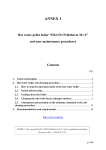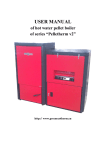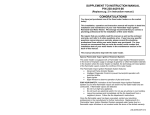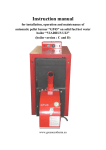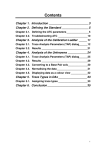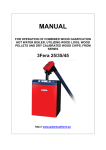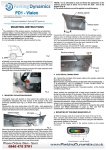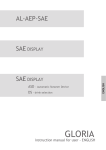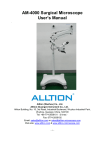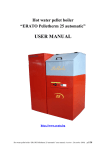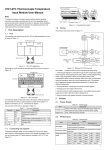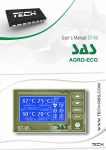Download Annex - Passport ERATO Pelletherm 60 v.2
Transcript
ANNEX 1 Hot water pellet boiler of series “Pelletherm v2” end-user maintenance procedures Contents p. 1. General principals ........................................................................................ 2 2. Hot water boiler ash cleaning procedure ................................................... 2 2.1. How to stop the operation mode of the hot water boiler ................... 3 2.2. Switch off the boiler............................................................................... 3 2.3. Cooling down the boiler ........................................................................ 4 2.4. Cleaning the ash of the heat exchanger surfaces................................ 4 2.5. Attachment and assembly of the elements, detached at the ash cleaning procedure......................................................................................... 14 3. Recommendations and requirements ....................................................... 14 http:// www.greenecotherm.eu ANNEX 1 Hot water pellet boiler of series “Pelletherm v2” end-user maintenance procedures (Document edition : 29/10/2012 14:55) p. 1/14 1. General principals The fuel of the hot water pellet boiler of series “Pelletherm v2” is wood pellets (or any other, verified and described in the user manual of the boiler) and the residual of the combustion process is mineral ash. The quantity of the ash depends on the fuel mineral mass content, i.e. fuel’s quality. The practice shows that main part of the ash residue is collected in the ash hopper of the boiler, however ash is deposited on the heat exchanging surfaces as well and other surfaces that are in direct contact with the flue gases (the burner, the flue gas fan, etc). The ash residue quantity, collected in the main ash hopper (positioned in the combustion chamber) should be cleared periodically, considering the operating mode of the boiler as well as the fuel quality. The practice shows that according to the ash in that hopper should be cleaned (thrown away) periodically – between one and five days (the fuel should cover the requirements, depicted in the user manual of the boiler). It is advisable to clean the convective part of the heat exchanger – by utilizing the applied the specialized lever – it should be plugged in the profiled orifice and swing the lever in both direction several times (which actually will activate the semi-mechanized cleaning system of the boiler). The total ash cleaning procedure should be performed once per month – advisably, but not more that two months period of hot water boiler’s operation. The period between ash cleaning of the boiler should be clarified at practice, as it depends mainly on the fuel quality. 2. Hot water boiler ash cleaning procedure ATTENTION – it is strongly recommended to have self protection – utilize gloves, protection glassed and appropriate clothing, as the risk of injuries is high at high temperatures of the surfaces in the combustion chamber of the unit. The following sections will describe the cleaning ash cleaning procedures in details. p. 2/14 Figure 2.1. Working gloves and working apron, provided for easy and safe cleaning process of the ash residue. 2.1. How to stop the operation mode of the hot water boiler The nominal operation of the boiler should be stopped by switching off its operating mode – refer to the boiler’s user manual for more details. After the boiler has been stopped, it takes time until the fuel, which is burning in the burner will be entirely combusted and the heat exchanger is cooled down to safe levels of the temperature; 2.2. Switch off the boiler The final shutdown of the boiler going through the switch "POWER", the condition for this switching is the combustion process has subsided. It is forbidden to stop the boiler through the "POWER" switch at work! p. 3/14 2.3. Cooling down the boiler After the boiler is switched off it should be cooled down – it is necessary to wait until the temperature of the circulating water is moderate and the heat exchanging surfaces are cooled down to safe levels and the ash cleaning procedure could start. 2.4. Cleaning the ash of the heat exchanger surfaces Before the ash cleaning it is necessary to open the top cover of the heat exchanger body. Unscrew the fixing nuts and remove the flue gas duct lid Figure 2.2. The top cover of the heat exchanger is lifted up. The fixing nuts should be unscrewed and flue gases duct lid should be removed. p. 4/14 Figure 2.3. The flue gases duct lid is detached (the ash residue is clearly seen on the boiler’s heat exchanger surfaces); Utilize appropriate tool to clean (to grate) the ash and char deposition off the internal surfaces of the boiler’s body. ATTENTION : the practice shows that the ash grating is connected with intensive release of fly ash, thus it is highly recommended to wear air breathing protective mask as well as appropriate clothing in order to minimize any lung issues and cloth staining; p. 5/14 Figure 2.4. Ash deposits cleaning; Figure 2.5. Brushing the ash layer of the heat exchanger surfaces; The next step of the cleaning procedure is to clean the ash deposits on the third part of the flue gases duct of the boiler. p. 6/14 Figure 2.6. Cleaning the ash deposits off the heat exchanger surfaces, as well as off the ash cleaning mechanism; The ash should be thoroughly cleaned off the metal parts (from the cleaning mechanism and the heat exchanger as well). p. 7/14 EXPLANATION : the ash particles, laid on the horizontal surface of the heat exchanger (at the flue gas pipes side) could be cleared by a specialized vacuum cleaner or it could be swept down through the pipes to the surfaces underneath – the ash will be cleaned from the surfaces underneath. Detailed description will be shows in the next sections; The next step of the cleaning procedure is to clean the internal surfaces of the pipes of the heat exchanger – this is done by manual movement of the pipe’s ash cleaning mechanism; Ash cleaning lever, used to clean the ash residue off the pipe’s heat exchanger surfaces Figure 2.7. Attachment of the heat exchanger pipes ash cleaning actuating lever; The next step is to detach the front face panel of the heat exchanger in order to get access to the lid of the second ash deposition zone of the boiler – the area right above the burner and below the pipes. p. 8/14 Figure 2.8. Detaching the front panel of the heat exchanger; The next step is to unscrew the fixing nuts of the lid, which closes the secondary ash deposition zone of the three way flue gas duct of the heat exchanger. Notice that the lid is tightened in order to prevent any flue gases leakage or ambient air both in and out of the flue gas duct. Figure 2.9. The lid of the secondary ash deposition zone is detached and the ash layer should be cleaned away; p. 9/14 Figure 2.10. Cleaning of the ash in the secondary deposition zone of the heat exchanger (right beneath the pipes of the heat exchanger); EXPLANATION : it is recommended to position the ash hopper in a position, which will allow easy collecting of the ash residue; The next step is to clean the ash and char residue, deposited in the burner. ATTENTION: before lifting up the cover of the burner, it is necessary to make a safety check, i.e. to verify that the temperature of the burner’s details is low enough to handle and continue with the manipulations. It is strongly recommended to get measures for self protection. Figure 2.11. Lift of the burner's arc lid; EXPLANATION : the lid of the burner is freely mounted and no fixing items are used. It is positioned by special locking pins, fixed to the lower part of the burner in its front side. p. 10/14 Figure 2.12. Ash and char cleaning procedure of the material, laid on the burner’s grate; Figure 2.13. Brushing and cleaning the ash residue and any other char remaining particles on the burner’s grate; After the burner’s grate has been thoroughly cleaned, it is necessary to clean the ash beneath the grate. p. 11/14 EXPLANATION: the burner’s grate is detached by lifting and alongside pulling action. It is possible to have difficulties when detaching the grate due to the deposited ash and eventually any thermal deformation of the details. It is necessary to take care at the grate removal procedure and to keep the ash grating element not damaged (it is not necessary to apply excessive force in order to remove away the grate). Ash grating element, moved forward-backward by special mechanism Figure 2.14. Detaching the grate of the specialized burner; p. 12/14 Figure 2.15. Cleaning the ash residue, fallen beneath the grate of the burner; The next steps are to take away the ash hopper, placed on the bottom of the combustion chamber, to deposit away the ash residue in special fire protected container. The cooled down ash could be utilized as soil fertilizer. Figure 2.16. Tacking the ash hopper out of the combustion chamber; p. 13/14 2.5. Attachment and assembly of the elements, detached at the ash cleaning procedure The attachment procedure should be done in reverse sequence of the steps, depicted in the previous sections of the manual. ATTENTION: it is necessary to ensure air-tightness if the lids of the flue gases duct of the boiler (these are the lid of the ash deposition secondary zone, as well as the top lid, covering the flue gases duct of the heat exchanger), in order to ensure high reliability and efficiency of the appliance. 3. Recommendations and requirements It is highly recommended to perform the above described procedure of ash deposition cleaning as it will ensure high efficiency and reliability of the boiler. It is recommended to ash clean the unit on a period of a month of operation, but it is necessary to clean the ash on operation period of no more than two months, considering the operating mode of the boiler as well as the ash content of the raw fuel; ATTENTION: • After each cleaning procedure, the boiler should be checked out – the correct attachment of the element, the air-tightness of the lids and the boiler’s functionality; • At the end of the heating season it is necessary to perform thorough ash cleaning of the boiler, because the mineral ash acts as corrosive reagent and reduces the reliability of the boiler. It is recommended to take away of the fuel hopper any pellets (of other fuel if utilized) as the pellets could absorb moisture from the ambient air and cause clogging of the fuel transport auger, issues with the ignition, etc.; The above depicted ash cleaning procedure is OBLIGATORY. In case that the ash cleaning and boiler’s maintenance procedures are not followed, it is possible to decrease the efficiency and performance reliability of the boiler, even operation failure could be achieved (for example clogging of the ash cleaning mechanism, flue gas fan blockage, etc.). p. 14/14














